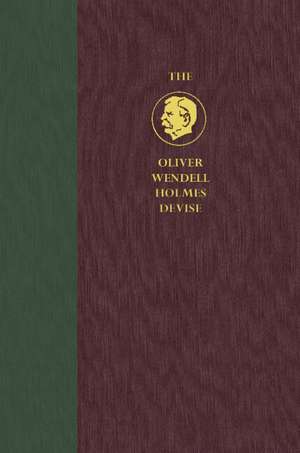The Hughes Court: Volume 11: From Progressivism to Pluralism, 1930 to 1941: Oliver Wendell Holmes Devise History of the Supreme Court of the United States
Autor Mark V. Tushneten Limba Engleză Hardback – 2 feb 2022
Preț: 1547.24 lei
Preț vechi: 2009.41 lei
-23% Nou
Puncte Express: 2321
Preț estimativ în valută:
296.07€ • 316.60$ • 246.85£
296.07€ • 316.60$ • 246.85£
Carte disponibilă
Livrare economică 27 martie-10 aprilie
Preluare comenzi: 021 569.72.76
Specificații
ISBN-13: 9781316515938
ISBN-10: 1316515931
Pagini: 1272
Dimensiuni: 165 x 241 x 60 mm
Greutate: 2.13 kg
Ediția:Nouă
Editura: Cambridge University Press
Colecția Cambridge University Press
Seria Oliver Wendell Holmes Devise History of the Supreme Court of the United States
Locul publicării:New York, United States
ISBN-10: 1316515931
Pagini: 1272
Dimensiuni: 165 x 241 x 60 mm
Greutate: 2.13 kg
Ediția:Nouă
Editura: Cambridge University Press
Colecția Cambridge University Press
Seria Oliver Wendell Holmes Devise History of the Supreme Court of the United States
Locul publicării:New York, United States
Cuprins
Acknowledgments; Introduction; Preface; Part I. The Opening Years: Section A. Setting the Stage; 1. Personnel and Organizing Ideas; 2. Formulas and Conceptions of Basic Needs: An Overview; 3. The Complex World of Simple Formulas; 4. Formulas and Considerations of Basic Needs in Business Regulation Cases; Section B. The False Dawn; 5. Blaisdell; 6. Nebbia; 7. The Gold Clause Cases; Section C. Crisis; 8. Black Monday 1935; 9. Winter 1935–36; 10. Spring 1936; 11. The Court-Packing Plan; 12. Resolution; 13. Was There a 'Switch in Time'?; Section D. The New Constitutional Regime; 14. After the Storm: Personnel and Organization; 15. Consolidating the Scope of National Power; 16. Consolidating State Regulation of Business; 17. Consolidating Labor Law and Intergovernmental Immunity; 18. Toward a Theory of Pluralism; Part II. Continuities: Section A. Administrative Law; 19. Administrative Law Introduction; 20. Administrative Law Constitutional Limits; 21. Administrative Law Presidential Power; 22. Administrative Law Courts' Role; Section B. Civil Liberties and Civil Rights; 23. The Uncertainty of Theory; 24. Progressivism, Prohibition, and Organized Crime; 25. Race, Criminal Justice, and 'Labor Defense'; 26. Race and Strategic Litigation; 27. Radical Political Dissent; 28. Radical Religious Dissent; Section C. Justiciability; 29. Basic Concepts of Justiciability; 30. Sovereign Immunity and Political Questions; 31. Regulating Access to the National Courts; 32. Erie; 33. Erie's Legacy; 34. Form and Style in Statutory Interpretation; Part III: New Approaches Begin to Emerge: Section A. Economics; 35. New Deal Economics; 36. Regulating Strikes; 37. Regulating the NLRB; 38. The Labor Antitrust Interface; Section B. Civil Liberties After 1937; 39. The Justices and the Theories; 40. Demonstrations, Picketing, and First Amendment Theories; 41. The Jehovah's Witnesses and First Amendment Theories; 42. Conclusion; Historiographical Essay; Index.
Recenzii
'No one understands the politics of law better or takes the law more seriously than Mark Tushnet. With a complete mastery of the decisions of the Hughes Court, Tushnet shows us the justices as they saw themselves, professionals of disparate backgrounds, temperaments, and talents, dispatching, with the tools at hand, the disputes that ceaselessly came to them. Familiar constitutional landmarks are here, as is the high drama of Franklin D. Roosevelt's 'Court-packing' plan, but so are more gradual changes in the law of the presidency, the administrative state, the federal courts, civil liberties, and civil rights that ended with the nation on the verge of a new constitutional order. Despite economic calamity and social strife, the Supreme Court thrived, not by being above politics, but by proving its worth by doing its job.' Daniel R. Ernst, Carmack Waterhouse Professor of Legal History, Georgetown University Law Center
'In this tour de force, a master doctrinalist unpacks some of the twentieth century's most significant cases. In the process, he brilliantly unlocks the mystery of the Constitutional Revolution of 1937 that did not happen, investigates the invention of federal jurisdiction, explores the evolution of the administrative state, and illuminates the transformation of modern American liberalism. Bravo!' Laura Kalman, Distinguished Research Professor, University of California, Santa Barbara
'In this tour de force, a master doctrinalist unpacks some of the twentieth century's most significant cases. In the process, he brilliantly unlocks the mystery of the Constitutional Revolution of 1937 that did not happen, investigates the invention of federal jurisdiction, explores the evolution of the administrative state, and illuminates the transformation of modern American liberalism. Bravo!' Laura Kalman, Distinguished Research Professor, University of California, Santa Barbara
Notă biografică
Descriere
A comprehensive study of the US Supreme Court that explores the transformation of constitutional law from 1930 to 1941.











